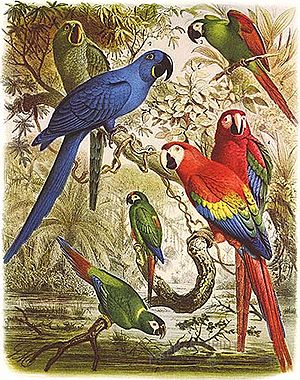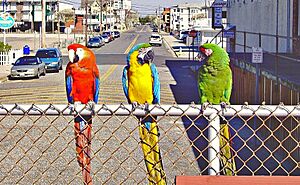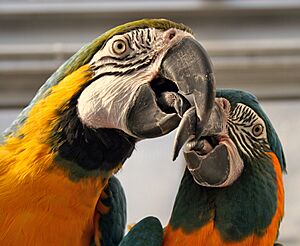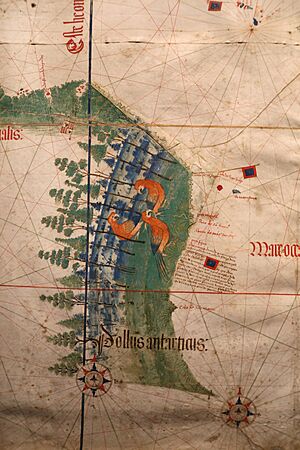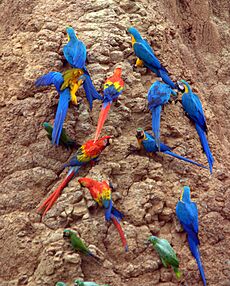Macaw facts for kids
Quick facts for kids Macaw |
|
|---|---|
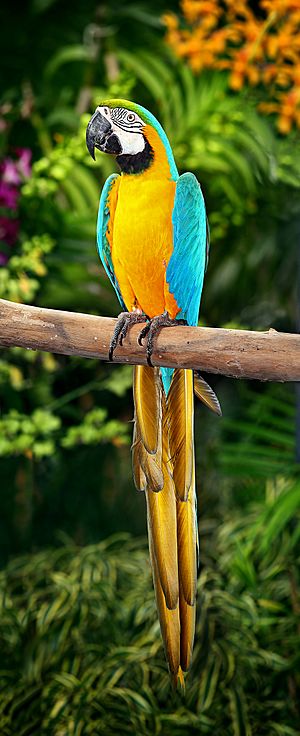 |
|
| A blue-and-yellow macaw (Ara ararauna) | |
| Scientific classification | |
| Kingdom: | Animalia |
| Phylum: | Chordata |
| Class: | Aves |
| Order: | Psittaciformes |
| Family: | Psittacidae |
| Subfamily: | Arinae |
| Tribe: | Arini |
| Groups included | |
|
Anodorhynchus |
|
Macaws are amazing, colorful parrots found in the Americas. They have long tails and bright feathers. Many people love macaws as pets, but sadly, some types are in danger in the wild.
Contents
What Are Macaws?
Macaws belong to a large group called true parrots. There are six main types, or genera, of macaws: Ara, Anodorhynchus, Cyanopsitta, Primolius, Orthopsittaca, and Diopsittaca.
Macaws live in Central America, South America, and parts of Mexico. In the past, they also lived in the Caribbean. Most macaws prefer forests, but some live in woodlands or open areas like savannas.
How to Spot a Macaw
Macaws stand out from other parrots. They have very large beaks and long tails. They also have bare, light-colored skin patches on their faces. These patches are usually around their eyes and near their beak. For some macaws, like those in the Anodorhynchus group, these patches might be smaller and yellow. Each macaw's facial feather pattern is as unique as a human fingerprint!
Macaw Sizes
Macaws come in different sizes. The biggest ones are the hyacinth, Buffon's (great green), and green-winged macaws.
There are also "mini-macaws" like the Spix's macaw, Red-bellied macaw, and those in the Primolius group. These are much smaller than the giant macaws. The smallest macaw, the Red-shouldered macaw, is about the same size as some parakeets!
Macaw Feet
Like other parrots, macaws have special feet called zygodactyl feet. This means they have two toes pointing forward and two toes pointing backward. This helps them grip branches and hold food.
Types of Macaws
There are 19 known species of macaws. This includes species that are now extinct or are critically endangered. Scientists have also suggested a few other extinct species, but there isn't much proof for them.
- Anodorhynchus
- Glaucous macaw, Anodorhynchus glaucus (possibly extinct)
- Hyacinth macaw, Anodorhynchus hyacinthinus
- Lear's macaw, Anodorhynchus leari
- Cyanopsitta
- Spix's macaw, Cyanopsitta spixii (probably extinct in the wild)
- Ara
- Blue-and-yellow macaw, Ara ararauna
- Blue-throated macaw, Ara glaucogularis
- Military macaw, Ara militaris
- Great green macaw, Ara ambiguus
- Scarlet macaw, Ara macao
- Red-and-green macaw, Ara chloropterus
- Red-fronted macaw, Ara rubrogenys
- Chestnut-fronted macaw, Ara severus
- †Cuban red macaw, Ara tricolor (extinct)
- †Saint Croix macaw, Ara autochthones (extinct)
- Orthopsittaca
- Red-bellied macaw, Orthopsittaca manilatus
- Primolius
- Blue-headed macaw, Primolius couloni
- Blue-winged macaw, Primolius maracana
- Golden-collared macaw, Primolius auricollis
- Diopsittaca
- Red-shouldered macaw, Diopsittaca nobilis
Macaws That Might Have Existed
Some macaws are called "hypothetical extinct species." This means scientists think they might have existed, but there's very little proof. They might have been types of macaws that were brought to an island and later thought to be new species.
Macaws in Danger
Most macaws are now in danger of disappearing from the wild. Some are already extinct. For example, the Spix's macaw is probably gone from the wild. The glaucous macaw is also likely extinct.
The biggest threats to macaws are forests being cut down and illegal trapping for the pet trade. Long ago, Native Americans in the American Southwest even raised macaws in places called "feather factories."
To protect macaws, their trade is controlled by an agreement called CITES. Some macaws, like the scarlet macaw, cannot be traded for money at all. Others, like the red-shouldered macaw, can be traded if certain rules are followed.
Macaw Hybrids
Sometimes, different types of macaws are bred together to create hybrids for the pet trade. For example, a blue-and-yellow macaw and a red-and-green macaw can create a "harlequin" macaw. Other common hybrids include the "miligold" and the "Catalina" macaws.
What Macaws Eat
Macaws eat many different things, including seeds, nuts, fruits, and even leaves and flowers. For pet macaws, safe vegetables include carrots, corn, broccoli, and sweet potatoes.
Wild macaws often fly very far, sometimes over 100 kilometers, to find food that is ready to eat at different times of the year.
Why Macaws Eat Clay
In some parts of the Amazon, hundreds of macaws gather at riverbanks to eat clay almost every day. Scientists used to think they ate clay to help digest poisonous things in their food. However, studies show that macaws actually prefer clay that has more salt. Salt is very important for animals, and it's hard to find in areas far from the ocean. This is why the biggest clay licks are found deep in the Amazon, far from the coast.
Interestingly, macaws outside the western Amazon don't eat clay, even if they eat some toxic foods. Also, macaws don't eat more clay if they eat more seeds (which can have more toxins).
Scientists have also noticed that macaws eat more clay during their breeding season. They even feed clay to their babies! One idea is that the clay might provide important vitamins, like vitamin B12.
Macaws and People
Macaws and their beautiful feathers have been important to people for a very long time. Ancient civilizations, like the Inca and Nazca, loved macaw feathers for their bright colors. They got feathers by hunting or trading. Feathers were used for decorations and found in special places like burial sites. Weavers in South America used feathers to make amazing clothes and panels.
Related Pages
Images for kids
-
Blue-and-yellow macaws (Ara ararauna)
-
Military macaw (Ara militaris)
-
Wing clipped scarlet macaws (Ara macao)
-
Golden-collared macaw (Primolius auricollis)


